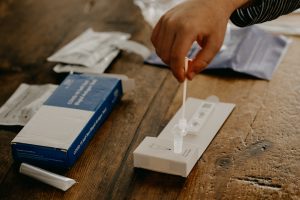March 6, 2022
United States: Cumulative Cases: 80,913,249, Cumulative Deaths: 983,912
World: Cumulative Cases: 445,921,999, Cumulative Deaths: 6,017,821
OHSU Finds 30% of People with COVID Have Long-Lasting Symptoms

Doctors at Oregon Health & Science University conducted a study that found that roughly 30% of patients that tested positive for COVID-19 have symptoms that can last up to several months.
Dr. Eric Herman with OHSU said those who are susceptible to long COVID-19 symptoms months after they’ve tested positive can carry those for roughly a year, sometimes longer. Some of those symptoms include fatigue, memory loss and breathing difficulties.
In a forecast released by OHSU on March 3, they anticipate a continued decline in new or breakthrough cases.
“There aren’t enough susceptible people in Oregon right now to generate another surge in hospitalizations,” said Peter Graven, Ph.D., director of the OHSU Office of Advanced Analytics.
Graven expects hospitalizations to continue falling as the omicron variant finds fewer and fewer people who haven’t already been infected, vaccinated or both.
Oregon, Washington and California jointly announced this week that all three states will lift indoor mask requirements on March 12. Gov. Kate Brown announced the statewide public health state of emergency will end on April 1.
By Jennifer Williams
March 5, 2022
Benton County: New Cases: 25, Cumulative Cases: 14,865, Cumulative Deaths: 62
Oregon: New Cases: 714, Cumulative Cases: 696,717, Cumulative Deaths: 6,709
National Vaccine Availability Outpaces Demand
 Recently, demand for COVID-19 vaccines has fallen off a cliff; about 70,000 Americans are getting their first shot every day, the lowest rate since the vaccination campaign began in December 2020. Even in Oregon, where the vaccination rate is a little higher than the national average, health authorities report a “significant excess” of 716,000 doses. Millions upon millions of doses have already gone to waste as a result of expiration, storage issues, breakage, or a patient not returning for a second dose.
Recently, demand for COVID-19 vaccines has fallen off a cliff; about 70,000 Americans are getting their first shot every day, the lowest rate since the vaccination campaign began in December 2020. Even in Oregon, where the vaccination rate is a little higher than the national average, health authorities report a “significant excess” of 716,000 doses. Millions upon millions of doses have already gone to waste as a result of expiration, storage issues, breakage, or a patient not returning for a second dose.
Vaccines authorized in the United States are usable for up to six months. States anticipate that a portion of the excess doses will be used in booster campaigns.
Vaccine waste is typical of any widespread attempt to vaccinate people, given vaccines’ limited shelf lives, but this round of waste arrives a year after hospital board members, trustees, and hospital donors around the country got early access to vaccinations. This contrasts strongly with the struggles of many people in poorer nations to receive the vaccine; according to Phionah Atuhebwe, an officer for the World Health Organization’s regional office for Africa, 13 countries in Africa have a full-vaccination rate of less than 5%. This is largely the result of poor infrastructure for distribution, limited access to necessary materials like syringes, unreliable delivery routes, misinformation and medical distrust, and vaccine hoarding by people in rich countries.
Dr. Joseph Bresee, director of the Covid-19 Vaccine Implementation Program at the Task Force for Global Health in Decatur, Georgia, explains, “the issue of some stockpiles in the U.S., Germany and Japan, that are not redistributed to sub-Saharan Africa, it’s less of an acute problem now because vaccine production and distribution is in high-gear right now serving those low-income countries.”
Dina Borzekowski, director of the Global Health Initiative at the University of Maryland, explains that “what is absent are best practices to get vaccines to populations who typically live without safely managed sanitation systems or reliable electricity.”
While many rich nations announced plans to donate vaccine doses, the delta and omicron variants quickly thwarted these intentions. And even when vaccines are donated, it can be impossible to keep them cold in transport and they sometimes arrive too close to expiration to be useful.
Claire Hannan, executive director at the Association of Immunization Managers in the United States, explains that “the most important thing is getting people vaccinated. And that’s hard when the demand goes down. You don’t have constant flow. But that’s just a necessary evil, I guess.”
By Grace Miller
March 4, 2022
Benton County: New Cases: 23, Cumulative Cases: 14,840, Cumulative Deaths: 62
Oregon: New Cases: 680 , Cumulative Cases: 696,003 , Cumulative Deaths: 6,686
To date, the state of Oregon has administered 10,510,237 Covid tests of which 918,104 came back positive.
CDC Says Covid Rates Higher Than Thought
 The Centers for Disease Control and Prevention estimate that, despite the fact that the U.S. has reported 74.3 million total cases of Covid, that the number is likely closer to 140 million
The Centers for Disease Control and Prevention estimate that, despite the fact that the U.S. has reported 74.3 million total cases of Covid, that the number is likely closer to 140 million
The study was a nationwide look at the antibody seroprevalence, which tested blood for antibodies which had been triggered by infection rather than vaccination. CDC took blood samples submitted for diagnosis for conditions other than Covid in all 50 states, Washington D.C., and Puerto Rico. The goal of the study is to determine an estimate of what percentage of the population had had the virus.
The results of the study found that, as of late January, 2022, approximately 43% of the country has had Covid. More specifically, nearly 60% of children up to age 18, almost 50% of those aged 18 to 49, 37% of people aged 50 to 64, and 23% of those over 65 have had the Covid virus.
Topping the list with the highest rate is Wisconsin at 56.1% while Vermont tapped in at the bottom of the list at 17.8%. Oregon landed low on the list with 28.2% of all residents having had Covid at some point.
By Sally K Lehman
Oregon Hospital Beds, a Rare Commodity
 It’s a pretty well-known fact at this point in the pandemic that hospital beds across the country have been a scarce commodity. While this is true, it would appear that Oregon had the worst of it – and started off the worst, too.
It’s a pretty well-known fact at this point in the pandemic that hospital beds across the country have been a scarce commodity. While this is true, it would appear that Oregon had the worst of it – and started off the worst, too.
According to KATU, Oregon has the fewest hospital beds per capita in the country. This, in tandem with a workforce shortage and the major issues in the healthcare system as a whole caused by this shortage, made Oregon, “Come close to the perfect storm.”
In fact, last year some parts of Oregon ended up needing the National Guard deployed to keep hospitals operational.
Becky Hultberg, president and CEO of the Oregon Association of Hospitals and Health Systems (OAHHS) told KATU, “We walked right up to the line of health system collapse, but we didn’t cross it. In 2021, when masks came off, when the Delta variant hit the state hard, we saw capacity challenges like we really had hoped to avoid.”
The Centers for Disease Control and Prevention keeps a list of hospital beds per 1,000 people in a given state. While Oregon had only 1.7 beds per 1,000 in 2019, the national average is 2.7 beds per 1,000. South Dakota has the highest hospital bed count per capita at 4.7 per 1,000 people.
Governor Kate Brown’s office said that one reason the state has such a low bed count is that it’s shifted to preventative and primary care, which should be a sign of a functioning healthcare system.
“Under normal circumstances, a low per-capita number of hospital beds is a sign of a health care system functioning as it is supposed to, by making sure people are getting the care they need, when they need it,” said a spokesperson for Brown. “When patients are receiving adequate primary and preventive health care, they do not end up in the emergency department or admitted to the hospital as frequently for chronic and severe illnesses and diseases.”
But Hultberg seems unsure of whether it’s time to up the bed count in Oregon hospitals. She told KATU, “I think this is a community-by-community conversation, and in some communities, we may need more capacity, but again, I think that’s a conversation that really needs to be determined in the local market.”
If Oregon is to reach a healthy goal of 2.5 beds per 1,000 people, Oregon Health and Science University’s expansion should help. They’re breaking ground soon on a $650 million expansion, which would see 184 beds and adult operating rooms within the next four years, expanding their capacity by roughly 33%.
While this project was started before the pandemic was a concern, COVID-19 has shown several holes in the state’s proverbial armor. Ultimately, though, this decision is up to Oregonian hospital systems and the OHA’s approval process.
By Ethan Hauck
March 3, 2022
Benton County: New Cases: 25, Cumulative Cases: 14,817, Cumulative Deaths: 62
Oregon: New Cases: 674 , Cumulative Cases: 695,323, Cumulative Deaths: 6,652
Masks Mandates Continue Some Places
While the Oregon Health Authority has agreed to uphold the end of the mask mandate on March 12, the following places will still require masks.
- Hospitals
- Doctor or Dentist Offices
- Urgent Care
- Ambulatory Surgical Centers
- Birthing Centers
- Inpatient Care or Long-Term Acute Care Facilities
- Hospice, Home Health Care, and In-Home Care
- Assisted Living or Nursing Facilities
- Dialysis Centers
- Pharmacies
- Any other facilities that provide health services including Mobile Clinics, Ambulances, or Medical Transport
More Free Covid Tests
 During the March 1 State of the Union address from President Biden, it was announced that a second wave of Covid tests would be made available from the government. The first wave of at-home tests were made available in response to the Omicron surge at the end of 2021. At that time, only 500 million tests were ordered, and now an additional 500 million have been order to bring the total to one billion.
During the March 1 State of the Union address from President Biden, it was announced that a second wave of Covid tests would be made available from the government. The first wave of at-home tests were made available in response to the Omicron surge at the end of 2021. At that time, only 500 million tests were ordered, and now an additional 500 million have been order to bring the total to one billion.
Beginning next week, the second wave of test will begin to ship. To get your free Covid tests, go to the United States Postal Service Covid-19 Test order form or to the CovidTests.gov website. The tests should take between seven and 12 days to be delivered.
By Sally K Lehman
March 2, 2022
Benton County: New Cases: 15, Cumulative Cases: 14,792, Cumulative Deaths: 61
Oregon: New Cases: 700 , Cumulative Cases: 694,649, Cumulative Deaths: 6,648
Lane County: Cumulative Cases: 56,239, Cumulative Deaths: 465
Lincoln County: Cumulative Cases: 6,914, Cumulative Deaths: 72
Linn County: Cumulative Cases: 25,976, Cumulative Deaths: 231
Marion County: Cumulative Cases: 68,262, Cumulative Deaths: 657
Polk County: Cumulative Cases: 15,090, Cumulative Deaths: 124
Baby Development in Covid
 There was a decrease in the birth rate in the U.S. between 2019 and 2020 – going down from 57.6 births per 1,000 women in 2019 to 53.9 births per 1,000 women in the last quarter of 2020. While birth rates have been trending lower since 2007, the expected decrease of 2.3% would account for only 1.3 fewer births per 1,000 women. The actual 3.7 births decrease is 4.3% higher.
There was a decrease in the birth rate in the U.S. between 2019 and 2020 – going down from 57.6 births per 1,000 women in 2019 to 53.9 births per 1,000 women in the last quarter of 2020. While birth rates have been trending lower since 2007, the expected decrease of 2.3% would account for only 1.3 fewer births per 1,000 women. The actual 3.7 births decrease is 4.3% higher.
Lower birth rates could be expected as people were required to stay apart for the month in 2019 and 2020 which would have made up the additional births in late 2020. Data shows that the decrease was most pronounced in the 15 to 24 age group and for those above 35, likely coinciding with accidental pregnancies, those in newer relationships, and those likely to already have a child.
More concerning for some researchers is the potential for lifelong damage for those babies born during the pandemic. The first three years of a child’s life are incredibly important in terms of brain development.
Babies need to be held, spoken to, and played with as a way to create neural connections and build their brains. Several studies have proven that maternal depression, poverty, and other stressors affect the development of a child. Children who are not interacted with enough can literally have smaller brains. And when caregivers are depressed, stressed out, or too busy to offer stimuli, it is the child who suffers.
A recent study out of Columbia University looked at two groups of six-month-olds – one group born to those sick with Covid, and the other born to those without Covid. A third group, looked at as an historical cohort, was born prior to the pandemic.
The study found that prenatal exposure to Covid did not affect development – which is great news. However babies born during the pandemic scored lower in gross motor, fine motor, and social-emotional skills. It was determined that this was likely due to emotional and financial stress coming from the pandemic.
By Sally K Lehman
March 1, 2022
Benton County: New Cases: 50, Cumulative Cases: 14,777, Cumulative Deaths: 61
Oregon: New Cases: 1,668, Cumulative Cases: 693,929, Cumulative Deaths: 6,622
Over the weekend, there were another 40 deaths statewide. Thankfully, none were in Benton County.
Mask Mandate to End March 12
With declining case rates and hospitalizations across the West, California, Oregon, and Washington are moving together to update their masking guidance. After 11:59 p.m. on March 11, California, Oregon, and Washington will be adopting new indoor mask policies and moving from mask requirements to mask recommendations in schools. Read more here…
Where Covid Came From
 Three new studies have been released concerning how the Covid pandemic began. Two of the reports bring the outbreak back to Wuhan, China and the massive market that sold live animals, while the third conjectures that this variety of the virus spilled over from animals to human – possibly from the market – at least twice in November and December of 2019. All three studies add weight to the suspicion that the pandemic did begin at the Huanan Seafood Market, citing the fact that several of those first infected had visited it.
Three new studies have been released concerning how the Covid pandemic began. Two of the reports bring the outbreak back to Wuhan, China and the massive market that sold live animals, while the third conjectures that this variety of the virus spilled over from animals to human – possibly from the market – at least twice in November and December of 2019. All three studies add weight to the suspicion that the pandemic did begin at the Huanan Seafood Market, citing the fact that several of those first infected had visited it.
The studies took into account genetic analysis of coronavirus collected from the market and from people infected in December 2019 and January 2020, as well as considering location coordinates connecting the samples to specific areas of the market. Similar research and tracing was done to pinpoint the beginnings or the SARS outbreak in 2002 – 2004.
While this research can point to where in the market Covid began, it cannot definitively determine what type of animal harbored the virus before spreading it to humans. Likely culprits are raccoon dogs – squat dog-like mammals used for food and fur in China – as several positive samples were collected near their enclosure.
Some scientists claim that the market may simply be a point of amplification in which an infected human spread Covid to several others.
None of the three studies has been peer-reviewed yet.
By Sally K Lehman
Feb. 28, 2022
United States: Cumulative Cases: 80,566,788, Cumulative Deaths: 973,052
World: Cumulative Cases: 435,649,989, Cumulative Deaths: 5,967,366
Since yesterday, another 6,495 new cases of Covid were reported in the U.S. In the world, the last 24 hours brought another 983,787 cases.
Over the last week, the U.S. has seen 12,895 more deaths from Covid. Worldwide, the reported death toll went up by 3,058,421 over this last week.
These numbers mean that the U.S. is approaching one million lives lost, while the world approaches six millions lives lost.
At The Advocate, we continue to urge everyone who can be vaccinated to get vaccinated.
COMMUNITY VACCINATION EVENTS
Corvallis
Location: Lincoln Health Center, 121 SE Viewmont Ave
Every Monday in March, from 10:00 a.m. – 7:00 p.m.
Every Wednesday in March, from 8:00 a.m. – 5:00 p.m.
Every Friday in March, from 8:00 a.m. – 5:00 p.m.
Oregon State University
Location: Oregon State University Memorial Union Room 62, 112 Memorial Union
Everyday Monday, February 28 to Friday, March 4, from 12:00 p.m. -7:00 p.m.
Location: SEC Plaza
Every weekday March 7 to March 18, from 12:00 p.m. – 7:00 p.m.
Monroe
Location: Monroe Health Center, 610 Dragon Dr
Every Tuesday in March, from 8:00 a.m. – 6:00 p.m.
Thursday, March 10 and 24, from 8:00 a.m. – 6:00 p.m.
Alsea
Location: Alsea Health Center, 435 E Alder St
Thursday, March 3, 17, and 31, from 8:00 a.m. – 4:00 p.m.
Do you have a story for The Advocate? Email editor@corvallisadvocate.com

